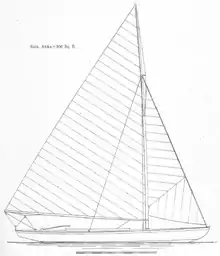18 foot dinghy
The 18 foot Dinghy was used in the 1920 Summer Olympics as a double handed Olympic class. One team was present at the starting line and won the gold. Three races were scheduled, with final places decided by total points with point-for-place scoring for each race. Only one race was started with only Great Britain competing but accounts vary as to if they finished the race.[1]

Probably the only sailing photo of the 18 foot dinghy left

Published in The Yachting Monthly 1919

Published in The Yachting Monthly 1919
 | |
| Development | |
|---|---|
| Designer | G.L. Watson & Co. |
| Year | 1919 |
| Boat | |
| Crew | 2 |
| Draft | 2.5 ft (0.76 m) |
| Hull | |
| Type | Dinghy |
| Hull weight | 2,750 lb (1,250 kg) |
| LOA | 24.5 ft (7.5 m) |
| LWL | 18 ft (5.5 m) |
| Beam | 6 ft (1.8 m) |
| Hull appendages | |
| Keel/board type | Fixed + Centerboard 1,200 lb (540 kg) |
| Rig | |
| Rig type | Bermuda rig |
| Sails | |
| Upwind sail area | 306 sq ft (28.4 m2) |
| Former Olympic class | |
Olympic results
Sources vary, giving the only participant the credits for the gold medal.[2] Others rank them as AC?[3]
| Games | Gold | Silver | Bronze |
|---|---|---|---|
| 1920 Antwerp |
Francis Richards Thomas Hedberg |
No further competitors | No further competitors |
References
- Sailing at the 1920 Antwerpen Summer Games: Mixed 18 foot Race One sports-reference.com, accessed 12 November 2018
- Wallechinsky, David (1 January 1988). The complete book of the Olympics. Viking. p. 577. ISBN 978-0-670-82110-5. Retrieved 11 December 2010.
- Mallon, Bill; Bijkerk, Anthony Th (December 2008). The 1920 Olympic Games: Results for All Competitors in All Events, with Commentary. McFarland & Co Inc Pub. p. 432. ISBN 978-0-7864-4070-2. Retrieved 11 December 2010.
This article is issued from Wikipedia. The text is licensed under Creative Commons - Attribution - Sharealike. Additional terms may apply for the media files.